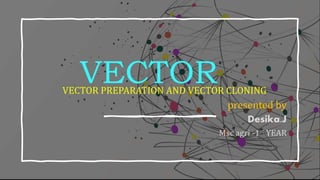
Vector Preparation and Cloning Techniques
- 1. VECTOR VECTOR PREPARATION AND VECTOR CLONING presented by Desika.J Msc agri -1st YEAR
- 2. VECTORS Small DNA molecule capable of self replication. Cloning vehicle or Cloning DNA. Carrier of DNA fragment. E.g. Plasmid, Phage, Hybrid vector, Artificial Chromosomes
- 3. CHARACTERISTICS Self replication, multiple copies Replication origin site. Cloning site. Selectable marker gene. Small size.
- 4. Low molecular weight. Easily isolated & purified. Easily isolated into host cell Control elements – promoter, operator, ribosome binding site
- 5. Preparation of vector DNA The cloning vector is treated with a restriction endonuclease to cleave the DNA at the site where foreign DNA will be inserted. The restriction enzyme is chosen to generate a configuration at the cleavage site that is compatible with the ends of the foreign DNA (see DNA end). Typically, this is done by cleaving the vector DNA and foreign DNA with the same restriction enzyme, for example EcoRI.
- 6. Most modern vectors contain a variety of convenient cleavage sites that are unique within the vector molecule (so that the vector can only be cleaved at a single site) and are located within a gene (frequently beta-galactosidase) whose inactivation can be used to distinguish recombinant from non- recombinant organisms at a later step in the process. To improve the ratio of recombinant to non-recombinant organisms, the cleaved vector may be treated with an enzyme (alkaline phosphatase) that dephosphorylates the vector ends. vector molecules with dephosphorylated ends are unable to replicate, and replication can only be restored if foreign DNA is integrated into the cleavage site.
- 9. VECTOR Plasmid Bacteriophages Cosmid Yeast Cloning Vectors Ti & Ri Plasmids TARGET HOST CELL Bacteria,Streptomyces Bacteria Bacteria Yeasts Transformation of cloned gene in higher plants.
- 10. AGENTS USED AS VECTORS PLASMIDS BACTERIOPHAGES COSMID ARTIFICIAL CHROMOSOME VECTORS In 1973, Cohen described first successful construction of recombinant vector. Plasmid PSC101 - Ecoli
- 11. PLASMID Extra chromosomal DNA molecules. Self replicating. Double stranded Short sequence of DNA. Circular DNA molecules Found in prokaryotes.
- 12. CHARACTERISTICS Minimum amount of DNA Two suitable markers for identification Single restriction site. More restriction enzyme. Relaxed replication control. Restriction endonuclease enzyme.
- 13. Three types of plasmids Fertility plasmids:- can perform conjugation. Resistance plasmids:- contain genes that build a resistance against antibiotics or poisons Col plasmids:- contain genes that code for proteins that can kill bacteria.
- 15. PBR322 Cloning Vector 15 copies. Reconstructed plasmid. Derived from Ecoli plasmid- ColE1.
- 16. PBR322 – 4362 base pairs P – denotes Plasmid B – Scientific Boliver R - Rodriguez 322 – number given to distinguish. Ampicillin resistance gene derived from RSF2124. Tetracycline resistance gene from PSC101. Origin of replication from PMB1. Two selectable markers Ampr tetr
- 17. Structure of E.Coli plasmidcloning vector pBR322
- 18. PBR327 Derived from PBR322. 30 – 40 copies. Expression plasmid. Ampilicin resistance gene. Tetracycline resistance gene Deletion of nucleotide between 1427 & 2516
- 19. pUC8 Popular Ecoli cloning vector Derivative of pBR322. Two parts derived Ampicillin resistance gene. ColEI – origin of replication 2700 base pairs lac Z gene derived from Ecoli. Polylinker sequence having unique restriction sites lies region in lac
- 20. PHAGE Cloning large DNA fragment Linear Phage molecule. Efficient than plasmid. Used in storage of recombinant DNA. Commonly used Ecoli phages :- λ phage, M13 Phage
- 21. BACTERIOPHAGE VECTORS Cloning Vectors. It infects bacteria. Commonly used Ecoli phages :- λ phage M13 Phage
- 22. Lambda phage vector Genome size is 48,502 bp. High transformation efficiency. 1000 times more efficient than the plasmid vector. Origin of replication Genome linear in head. Single- stranded protruding cohesive ends of 12 bases. Cos site – site of cleavage of phage DNA
- 24. Phage M13 Vectors Filamentous bacteriophage of Ecoli. Used for obtaining single stranded copies DNA sequencing. Single stranded. Inside host cell become double stranded
- 26. HYBRIDVECTOR Component from both plasmid & phage chromosomes. Helper phage provided. Developed in 1978 by Barbara Hohn & John Collins 30 – 40 Kb Origin of replication, cloning site, marker gene, DNA cos site. Smaller than plasmid. Use – construction of genomic libraries of eukaryotes. e.g. Cosmid
- 28. COSMIDS Combine parts of the lambda chromosome with parts of plasmids. Contain the cos sites of λ and plasmid origin of replication. Behave both as plasmids and as phages. Cosmids can carry up to 50 kb of inserted DNA. Structure of Cosmid Origin of replication (ori). Restriction sites for cleavage and insertion of foreign DNA. Selectable marker from plasmid. A cos site - a sequence yield cohesive end (12 bases). Ampicillin resistance gene (amp)
- 29. ARTIFICIAL CHROMOSOME Linear or Circular. 1 0r 2 copies per cell.
- 31. YAC – Cloning in yeast BAC & PAC – Bacteria MAC & HAC – Mammalian & Human cells
- 32. BACTERIAL ARTIFICIAL CHROMOSOME 1st BAC Vector – PBAC108L. Cloning of large regions of eukaryotic genome. Origin of replication from bacterium Ecoli F -factor. BAC vectors are pBACe3.6, pBeloBAC11. Used in analysis of genomes Host for BAC is mutant strain
- 33. YEASTARTIFICIAL CHROMOSOME Linear Plasmid Vector Clone large DNA segment ( 100 – 1400kb). Occurring two forms:- Circular – grows in bacteria. Linear – multiplies in yeast cells. pYAC3 - first YAC developed. It contains :- ARS sequence – replication CEN4 sequence – centromeric function TRP1 & URA3 – 2 selectable markers Use – mapping complex eukaryotic chromosome .